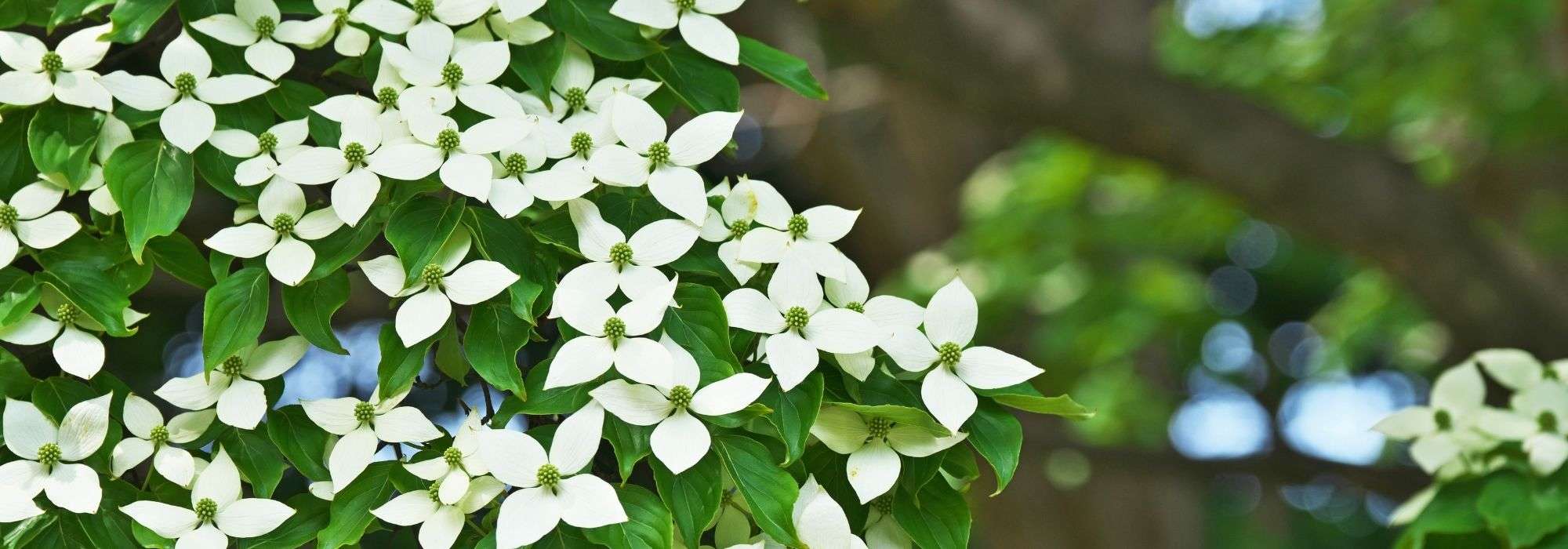
Cornus kousa, Japanese dogwood: choosing, planting, care
Contents
Japanese dogwoods in a nutshell
- Cornus kousa is a small tree or large bush of incredible elegance
- The spring flowering with large white or pink bracts is graphic and spectacular
- The foliage of Japanese dogwoods can change from green to bright red in autumn
- These small trees require humus-bearing soil, always moist but well-drained
- These flowering dogwoods can be grown in partial shade or full sun, isolated, with other trees and bushes, or in pots
The word from our expert
The Japanese dogwood or Cornus kousa is a charming small tree, admired for its flowering, autumn foliage, and striking appearance. Ultimately, Japanese dogwoods assert their presence throughout the year, and it would be a shame to miss out on them.
Around June, sometimes as early as May, the tree is literally covered with a multitude of large flowers with white or pink bracts depending on the variety. Subsequently, very decorative red fruits form, punctuating here and there the foliage, which gradually turns crimson in autumn. Once the leaves have fallen, a particularly graphic appearance is revealed, ensuring its delicate presence during the long winter months.
Contrary to a still widespread belief, these small trees are very hardy and quite easy to grow. You can cultivate your Cornus kousa in full sun or partial shade, in any neutral to acidic soil. Japanese dogwoods require a fairly humus-bearing soil that remains cool throughout the year but is well-drained.
Dogwoods can be planted as solitary specimens, in a grove, in a border, as a free-standing hedge, or even in pots. There are numerous varieties depending on the size and colour of the bracts; a more compact or spreading habit; variegated foliage or more or less colourful in autumn… In short, there are Cornus kousa for every taste!
Description and botany
Botanical data
- Latin name Cornus kousa
- Family Cornaceae
- Common name Japanese Dogwood, Kousa Dogwood, Flowering Dogwood
- Flowering May to July depending on varieties
- Height 3 to 6 m
- Exposure full sun to partial shade
- Soil type neutral to acidic, cool but well-drained
- Hardiness at least -15°C
Cornus kousa belongs to the family Cornaceae. These small trees or large bushes are native to Japan, the Ryukyu Islands, and Korea, and are even found naturally in northern India (Sikkim state) and Bhutan. It can rarely be found in old literature under the name Benthamidia kousa or Benthamidia japonica. In reality, the genus “Cornus” is divided into several subgenera: Cornus kousa belongs to the subgenus Benthamidia. Its common names are Japanese Dogwood, Kousa Dogwood, or simply Flowering Dogwood, the latter term unfortunately being potentially confusing with other dogwoods that have interesting flowering (Cornus florida, Cornus angustata, Cornus capitata, Cornus hongkongensis, Cornus nutallii…).
Japanese Dogwoods are large bushes or small trees with a spreading habit. The branches, well-branched, are most often arranged in tiers, almost like a pagoda (though not acquiring the remarkable habit of Cornus controversa or Cornus alternifolia). These small trees can reach a maximum height of 10 m with a spread of 4 m in about twenty years. The size strongly depends on the cultivated variety. The growth is moderate to slow.
The bark is grey. In some older specimens, the bark cracks and peels, revealing lighter patches on a dark grey background.
The foliage is opposite and deciduous. The leaves are medium to dark green, turning warm colours sometimes scarlet in autumn if the summer has been sufficiently sunny. Some varieties have variegated foliage such as ‘Samaritan’ with cream-margined green leaves or ‘Gold Star’ with green leaves speckled with bright yellow. The leaves, measuring 5 to 9 cm in length, are ovate to elliptical acuminate (= tapering to a point) with undulate margins. Some hybrids of Cornus kousa crossed with one of its evergreen relatives, Cornus capitata, have semi-evergreen foliage, notably ‘Norman Hadden’.
Flowering occurs in late spring between May and June and lasts, depending on the varieties, for a period of up to six weeks. The flower in the botanical sense is only at the centre of the bracts: in reality, it is a cluster of tiny flowers gathered in a head. Each flower consists of four small petals surrounding four stamens with double anthers arranged in a staggered pattern. This head is small and initially acid green, then yellow.
The actual flowers are somewhat insignificant as, in reality, it is the bracts surrounding them that are mistaken for the flower. These bracts are there to attract pollinating insects as dogwoods are entomophilous (they require insects to fertilise the flowers and produce fruits). The four petaloid bracts surrounding the flower are gathered in an involucre. These are oval and acuminate in shape, measuring about 4 cm long, sometimes more depending on the varieties. They are white to deep pink depending on the variety: ‘Scarlet Fire’ has very bright pink bracts.

Several colours of Cornus kousa: ‘Milky Way’, ‘Satomi’ and ‘Scarlet Fire’
The fruits that follow the flowers are edible but somewhat bland in flavour. They are fleshy, reddish drupes at maturity borne on long peduncles. These fruits, measuring 2 to 3 cm in diameter, are particularly aesthetic and remain on the tree from late summer until winter unless the wind and birds decide otherwise. Each fruit contains about ten seeds. It is not uncommon to find a few spontaneous seedlings under Cornus kousa. As these small trees sometimes hybridise with each other, you might have a lovely surprise when the flowers appear… only about fifteen years after germination.

Fruiting of Cornus kousa
Please note that flowering dogwoods in general take more than ten years, sometimes 20 years, to flower if they are from seed: Therefore, prefer grafted specimens whose flowering will follow quickly after planting!
Dogwoods in general are quite hardy as they all grow naturally in the Northern Hemisphere. This is also true for Cornus kousa which survives without flinching at temperatures dropping to -23°C.
“`
Main varieties
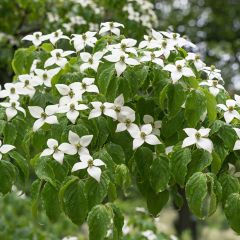
Cornus kousa var. chinensis - Flowering Dogwood
- Flowering time July, August
- Height at maturity 7 m
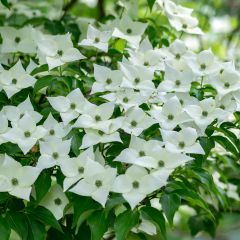
Cornus kousa Milky Way - Flowering Dogwood
- Flowering time June, July
- Height at maturity 5 m
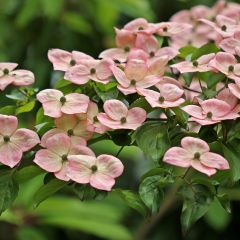
Cornus kousa Satomi - Flowering Dogwood
- Flowering time June, July
- Height at maturity 3,50 m
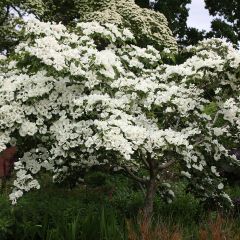
Cornus Venus - Flowering Dogwood
- Flowering time June, July
- Height at maturity 5 m
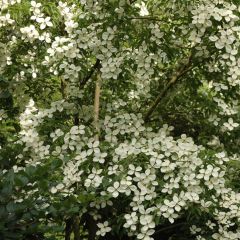
Cornus Norman Hadden - Flowering Dogwood
- Flowering time June to August
- Height at maturity 5 m
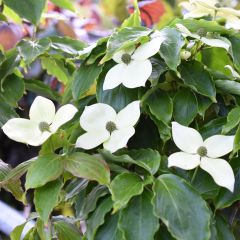
Cornus kousa Teutonia - Flowering Dogwood
- Flowering time July, August
- Height at maturity 3 m
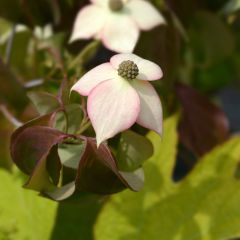
Cornus kousa Cappuccino - Flowering Dogwood
- Flowering time June, July
- Height at maturity 4,50 m
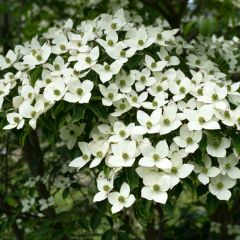
Cornus kousa Schmetterling - Flowering Dogwood
- Flowering time June, July
- Height at maturity 4 m
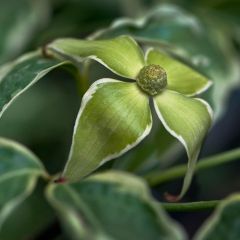
Cornus kousa Samaritan - Flowering Dogwood
- Flowering time June, July
- Height at maturity 5 m
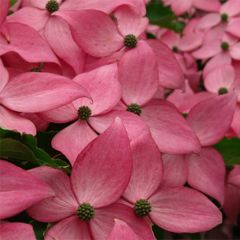
Cornus kousa Scarlet Fire - Flowering Dogwood
- Flowering time June, July
- Height at maturity 4,50 m
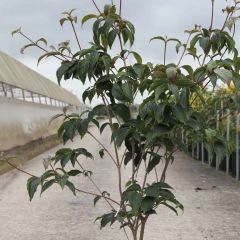
Cornus kousa Copacabana - Flowering Dogwood
- Flowering time June, July
- Height at maturity 3 m
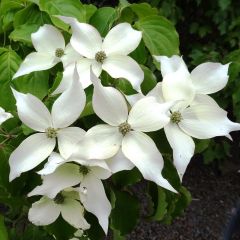
Cornus kousa Weisse Fontaine - Flowering Dogwood
- Flowering time July, August
- Height at maturity 5 m
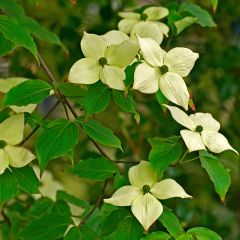
Cornus kousa China Girl - Flowering Dogwood
- Flowering time July
- Height at maturity 6 m
Discover other Cornus
View all →Available in 0 sizes
Available in 0 sizes
Available in 2 sizes
Available in 1 sizes
Available in 2 sizes
Available in 1 sizes
Available in 3 sizes
Available in 2 sizes
Available in 2 sizes
Available in 3 sizes
Planting Cornus kousa
Where to plant Cornus kousa?
In terms of soil, the Japanese Dogwood is less demanding than its American cousin, Cornus florida. The soil should be fertile, humus-bearing, and neutral to acidic. However, the Japanese Dogwood can tolerate a bit of lime. The ground must remain cool throughout the year, as if it becomes too dry, the tree will struggle. It can adapt to clay soils, but the soil must always be well-drained.
Regarding exposure, Cornus kousa will thrive in partial shade within a woodland setting. It can grow in full sun north of the Loire, but beware of the foliage in summer, which may scorch. Additionally, if the tree receives too much sun, it will lose its architectural form and grow more chaotically. Too much shade, on the other hand, will prevent the flowering dogwood from blooming well.
When to plant Cornus kousa?
It can be planted from March to April, or better yet in autumn: from October to November. Autumn planting will allow your dogwood to develop a good root system for the coming year.
How to plant Cornus kousa?
- Soak your potted dogwood in a large bucket of water for several minutes to rehydrate the root ball.
- Dig a hole twice the depth and width of the root ball. Keep the excavated soil and loosen it.
- Loosen the soil at the bottom of the hole using a hoe or pickaxe.
- If your soil is not well-drained (very compact soil), you can mix gravel with the excavated soil. Avoid Rhine sand, which can sometimes do more harm than good in very clayey soils, and forget about placing gravel at the bottom of the hole, as this will create a sort of “sump” filled with water right at the roots, which is not good either. Compost will also improve the soil texture.
- Remove your tree from its pot and check the quality of the roots. Cut away any damaged or rotten roots. Don’t hesitate to untangle the root ball and remove most of the potting soil, especially for an autumn planting.
- Add several handfuls of well-matured compost to the planting hole.
- Prepare a slurry for the roots: a few handfuls of soil, a good handful of decomposed manure, and add rainwater until it forms a sort of sticky mud. Dip the roots of your tree into this mud. The slurry will provide everything the roots need to kickstart their growth.
- Place your tree at the bottom of the hole, keep it upright, and then backfill the hole with your soil.
- Ensure that you do not cover the collar of the tree (the part between the roots and the aerial part). It’s best to plant on a slight mound. Keeping the collar above the soil allows lateral roots to spread and “breathe”. The tree is less prone to diseases, better anchored, and grows faster.
- Lightly firm the soil around the tree without damaging the roots and create a sort of basin around it to retain water at its base.
- Add ten litres of water. This step is important to avoid any “air pockets” between the roots and the soil.
- A good mulch of fallen leaves at the base or, even better, planting perennial groundcovers will help keep the soil cool throughout the year.
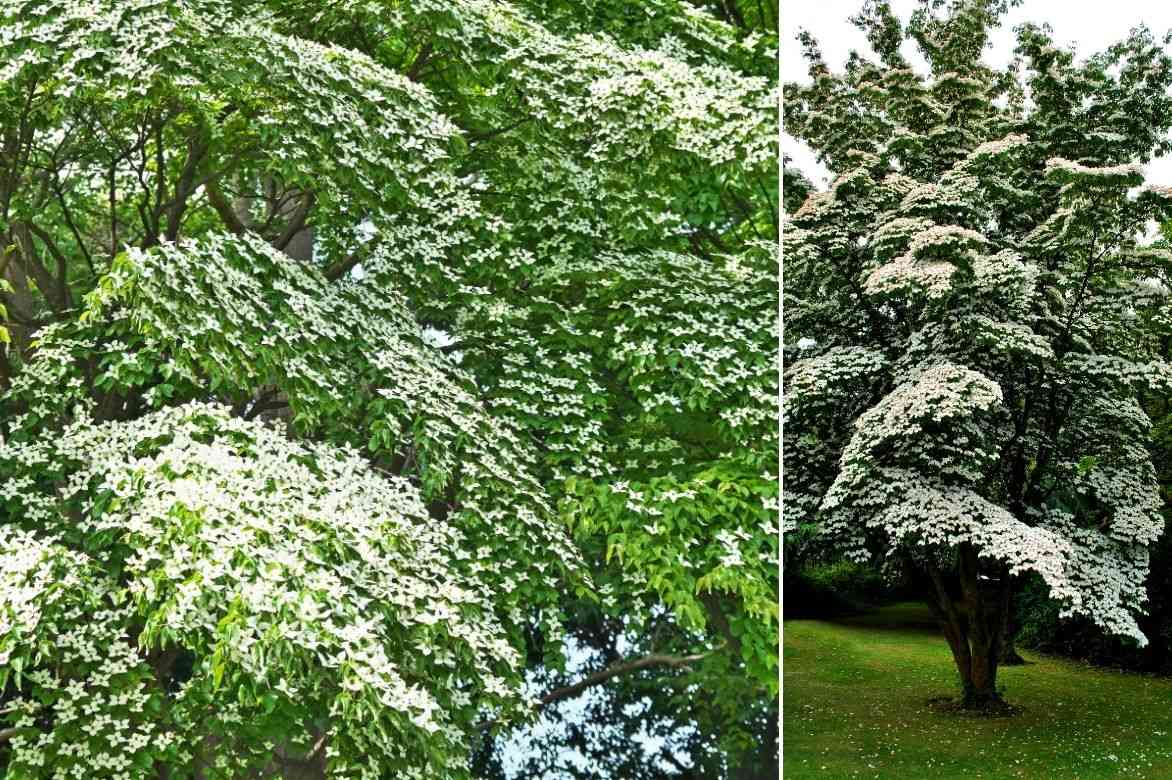 Cornus kousa Chinensis, majestic!
Cornus kousa Chinensis, majestic!
Care
Watering
For the first two years following planting, ensure to provide a good watering can of water if the weather is dry. After that, simply monitor during dry periods to ensure the tree is not suffering: scorched or drooping leaves are a warning sign.
Pruning
The Japanese Dogwood does not require pruning to flower well. You can remove dead wood at any time and prune after flowering, in July, to rebalance the branches. The less you prune, the less likely you are to introduce infections or degrade the natural appearance of your dogwood.
Pests and diseases
It is one of the dogwoods that is not very susceptible to anthracnose or any other disease.
Snails may nibble on the young leaves in spring without harming the tree.
The only two enemies of Cornus kousa are drought and scorching sun. Find it a good spot in partial shade with cool soil!
Multiplying Cornus kousa
By sowing
Sowing is possible but… very slow. It can take up to twenty years before you can enjoy the first flowers. However, if you are patient, simply collect seeds from ripe fruits in October-November, soak them for 24 hours, and then sow them in pots with well-draining substrate. Keep the pots in a cold greenhouse and only take them out the following spring. Place your pots in partial shade and keep the substrate moist without excess. Transplant your young plants individually when they have four leaves, then plant them in the ground the following autumn.
By cuttings
Propagation by cuttings of branches works but yields rather disappointing results. You can be pleased if you succeed with one out of three or four.
In September, select sections of semi-woody stems (beginning to lignify) about ten centimetres long. Remove the leaves and secondary branches but keep the last two leaves at the tip of the cutting. Place your cuttings in a light, well-draining substrate (such as seed compost) and keep them in a humid environment. After three months, you can transplant the cuttings individually into small pots to be placed in a cold, bright greenhouse (such as a garage or conservatory). It is important that the temperature does not drop below 10 °C. Keep the substrate moist without excess throughout the growing period. You will only be able to plant your successful cuttings the following autumn.
By layering
Layering is the most effective solution for propagating Cornus kousa. Two types of layering can be attempted to propagate Cornus kousa: coppicing, which is best reserved for specialists, and air layering.
Air layering: in April, choose a healthy, well-lignified one-year branch. Remove the lateral shoots and all leaves except for the last four at the tip of the branch. Carefully remove a ring of bark a few centimetres wide using a grafting knife. Prepare a black plastic sleeve (to prevent light from penetrating) to attach to the branch and fill it with well-moistened sphagnum moss. Close the sleeve around the “wound” so that the moss touches this area. Secure the sleeve on both sides with an elastic band or raffia. After several months, roots will develop within the sphagnum. At this point, it will be time to cut the branch and transplant this layer into a pot to be placed in partial shade. Keep the substrate always moist without excess, then replant the following autumn.
By grafting
Grafting is the only way to propagate hybrids and certain varieties of Cornus kousa. Shield grafting in July-August is the most effective method. The rootstock can be a Cornus florida, but it is best to choose a one-year scion from a typical Cornus kousa or a Cornus kousa Chinensis. Although ultimately simpler to perform than it seems, grafting is generally reserved for professionals.
→ Learn more about propagating dogwoods in our tutorial!
How to pair Cornus kousa?
A burst of colour in Osaka…
Japan is renowned, among other things, for its spring blooms. No longer settle for a pretty wallpaper on your computer; bring Japanese spring into your garden! The Cornus kousa ‘Satomi’ is an excellent choice for a bright, dappled shade grove. This classic variety of Japanese dogwood is truly remarkable for its dazzling flowering, featuring large, soft pink bracts in June, vibrant autumn colours, and its beautiful layered habit. To complement it, Japanese cherries are perfect. The Prunus subhirtella ‘Fukubana’ will bloom just before the dogwood, between March and April, in an explosion of intense pink flowers before the foliage appears. Just before this flowering, the Korean Forsythia or Abeliophyllum distichum ‘Roseum’ will add a touch of pink to the garden: from February to March. From May to June, the beauty bush or Kolkwitzia amabilis takes over with its dense and abundant flowering in candy pink to pale pink. In short, such a grove will provide flowers from February to early July, with blooms following or overlapping harmoniously for a long-lasting effect.

Association “A Burst of Colour in Osaka”: Abeliophyllum distichum ‘Roseum’, Prunus subhirtella ‘Fukubana’, Cornus kousa ‘Satomi’ and Kolkwitzia amabilis
An autumn atmosphere in Kyoto…
But Japan also enchants us in autumn with the foliage colours of trees and bushes. One of the most spectacular Japanese dogwoods in autumn is undoubtedly the Cornus kousa ‘Schmetterling’, with its foliage turning orange and then scarlet before falling to the ground in autumn. The large pink fruits are also very decorative and remain on the tree throughout autumn. When it comes to autumn colours in Japan, one cannot overlook a Japanese maple: the‘Acer palmatum ‘Shaina’ is a scarlet wonder from October. But let’s not forget the autumn blooms that will add even more colour to the ensemble: a Camellia sasanqua ‘Waterfall Pink’, this evergreen shrub will offer a cascade of double flowers in fresh pink from October to November; while the small Abelia x grandiflora ‘Caramel Charm’ will bloom with a multitude of pink and white flowers in summer and into early autumn, giving way to a rich mantle of russet bracts on semi-evergreen foliage of caramel colour.
Having tea on Hokkaido island…
Fancy a little Japanese scene on your terrace or a large balcony in dappled shade? This is entirely possible by carefully selecting your plants. Let’s start with one of the most compact cultivars among Japanese dogwoods: Cornus kousa ‘Copacabana’, which delights with the colour of its foliage that ranges from a gradient of red-purple to soft green, punctuated in June by a beautiful white flowering tinged with pink that contrasts perfectly with the foliage. To accompany it, what could be better than a lovely Japanese maple like this Acer palmatum ‘Orange Dream’, a variety with bright orange spring foliage, then light green in summer, finishing with golden yellow to bright orange in autumn. Let’s complete the picture with two evergreens: a lovely Japanese pine, Pinus parviflora ‘Kokuho’, which will not exceed one metre in height and will enchant you with its blue-green foliage and natural bonsai appearance; and a simple yet effective Pieris japonica ‘Flaming Silver’. This little shrub will bear magnificent spring foliage in scarlet red, contrasting with the mature leaves of dark green edged in cream, all adorned with a generous flowering in white, pendulous panicles.
Did you know?
- The English refer to Cornus kousa as Kousa ‘Dogwood’ or Chinese kousa ‘Dogwood’;
- The Japanese, on the other hand, call this dogwood: Yamabushi;
- Cornus kousa was introduced to Europe in 1875;
- The genus name “Cornus” refers to the hardness of the wood;
- The former genus name “Benthamidia” referred to George Bentham, a 19th-century English botanist;
- Professor Orton from Rutgers University in New Jersey conceived the idea of creating hybrids between Cornus florida and Cornus kousa to develop strains resistant to anthracnose, a disease that devastates Cornus florida: these trees are called Cornus x rutgersensis (Stellar series). In addition to being resistant, they display very colourful foliage in autumn and larger bracts.
- Other hybrids have been created by crossing Japanese dogwoods with other dogwoods (C. nutalii, C. capitata…);
- The fruits, although edible, are rarely consumed due to the numerous seeds and the bitter skin. The pulp has a taste reminiscent of ripe persimmon. However, they can be cooked into jam, sauce, or even made into wine;
- Young shoots and leaves can also be consumed.
Useful resources
- Discover our selection of flowering dogwoods from our online nursery.
- Advice sheet: 10 dogwoods for a small garden
Frequently asked questions
-
My soil is chalky. Can I try a Cornus kousa?
Even though Japanese Dogwoods prefer acidic to neutral soil, they can tolerate a bit of lime. Unlike other flowering Cornus, which cannot withstand lime at all. However, if your soil is really too limey, you will need to add some heather soil when planting your Cornus kousa and add a good layer of needle mulch at its base every year.
-
My garden is very small. I would like a Japanese Dogwood. Can I adopt one?
It all depends on the size of the garden! However, recently, new, more compact varieties have emerged: 'Copacabana' will not exceed 3 m in height and 2 m in width, 'Teutonia' will form a bush 3 m high and equally wide, and 'Schmetterling' will also remain quite compact... Moreover, most of these "small" Cornus kousa thrive quite well in a large container. It's worth trying to brighten up a terrace or even a sturdy balcony! In conclusion, do not hesitate to ask a specialist for all the information regarding the most compact varieties and their precise dimensions at ripeness. It would be a shame to have to prune a Cornus kousa that has become too large for your space.
-
My Japanese Dogwood still isn't flowering. What's going on?
It can be due to several factors. Firstly, Cornus kousa takes time to flower, especially if they are grown from seed. It can sometimes take up to twenty years before you see the flowers. Secondly, exposure is important. Japanese dogwoods dislike full sun (especially during hot summers) but appreciate a few hours of sunlight each day (at least four hours). If your tree is planted too much in the shade, it will not flower or will do so very little. Finally, excess nitrogen can sometimes prevent trees from flowering well. In this case, they produce only wood and foliage. It's also worth noting that a late frost, around May, can completely eliminate the floral buds of Cornus kousa. This is more common with earlier dogwoods like Cornus florida or Cornus nuttallii, but lately, we have had to endure some rather erratic seasons...
-
The foliage of my Cornus kousa is taking on strange hues. What is happening to it?
If it's autumn, all is well! If not, your tree is suffering. Brown and drooping leaves indicate either a lack of water or, conversely, root suffocation in overly heavy soil. In the first case, it's easy to resolve; a good watering followed by proper mulching should help it through this phase. In the second case, you'll need to work the soil to make it more draining (adding compost, gravel in the planting hole...), or even relocate the tree. Also, be aware that Japanese dogwoods dislike dry atmospheres, scorching sun, and desiccating winds that scorch the foliage.
- Subscribe!
- Contents
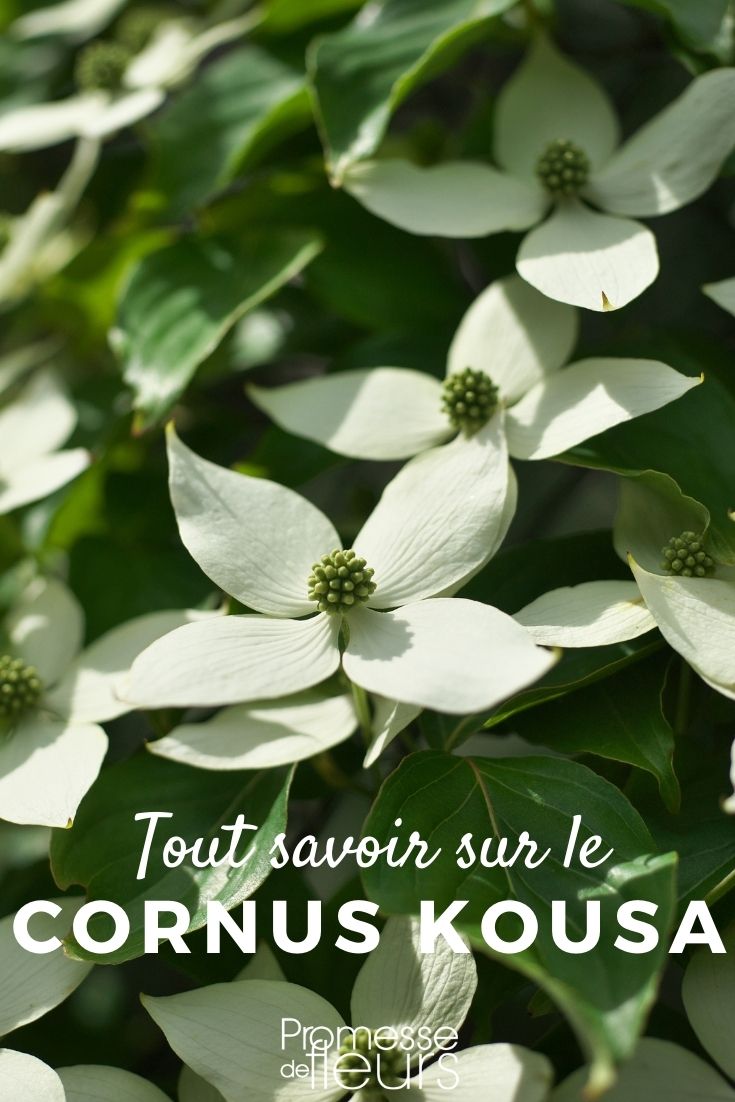































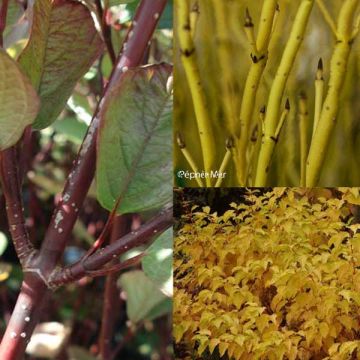
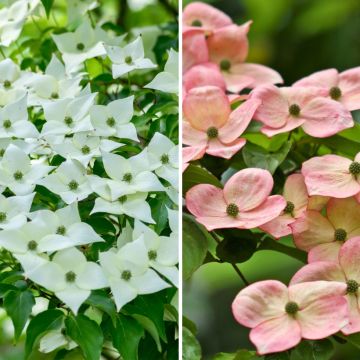
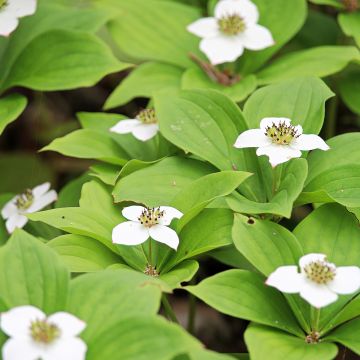
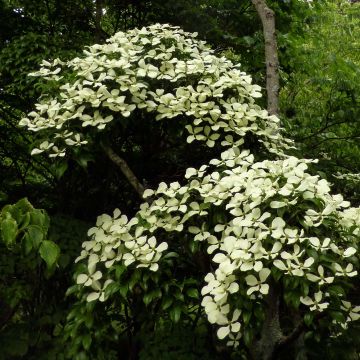
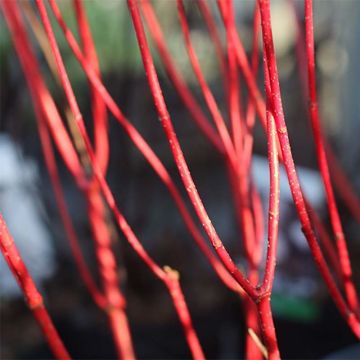
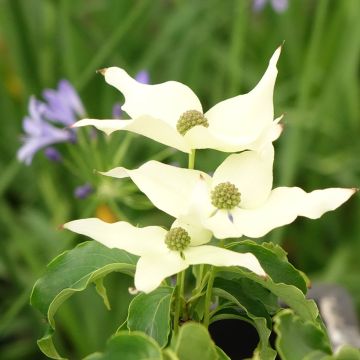
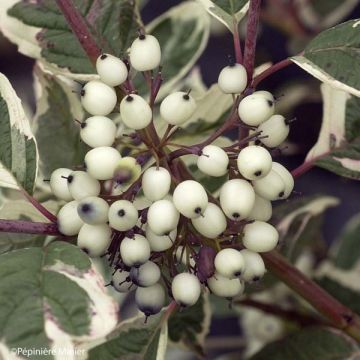
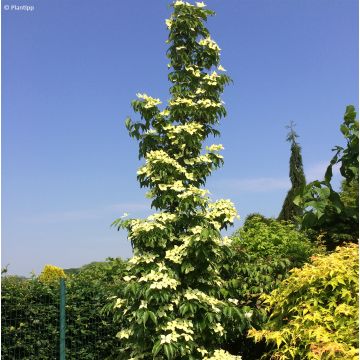

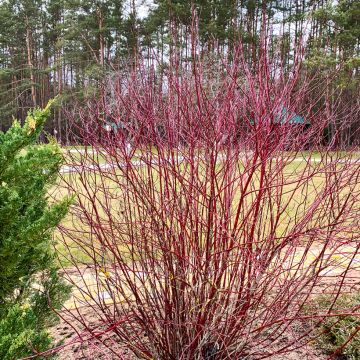
Comments